
21 minute read
DIVERSITY IS A REALITY, INCLUSION IS A CHOICE
STEVE FROST
Advertisement
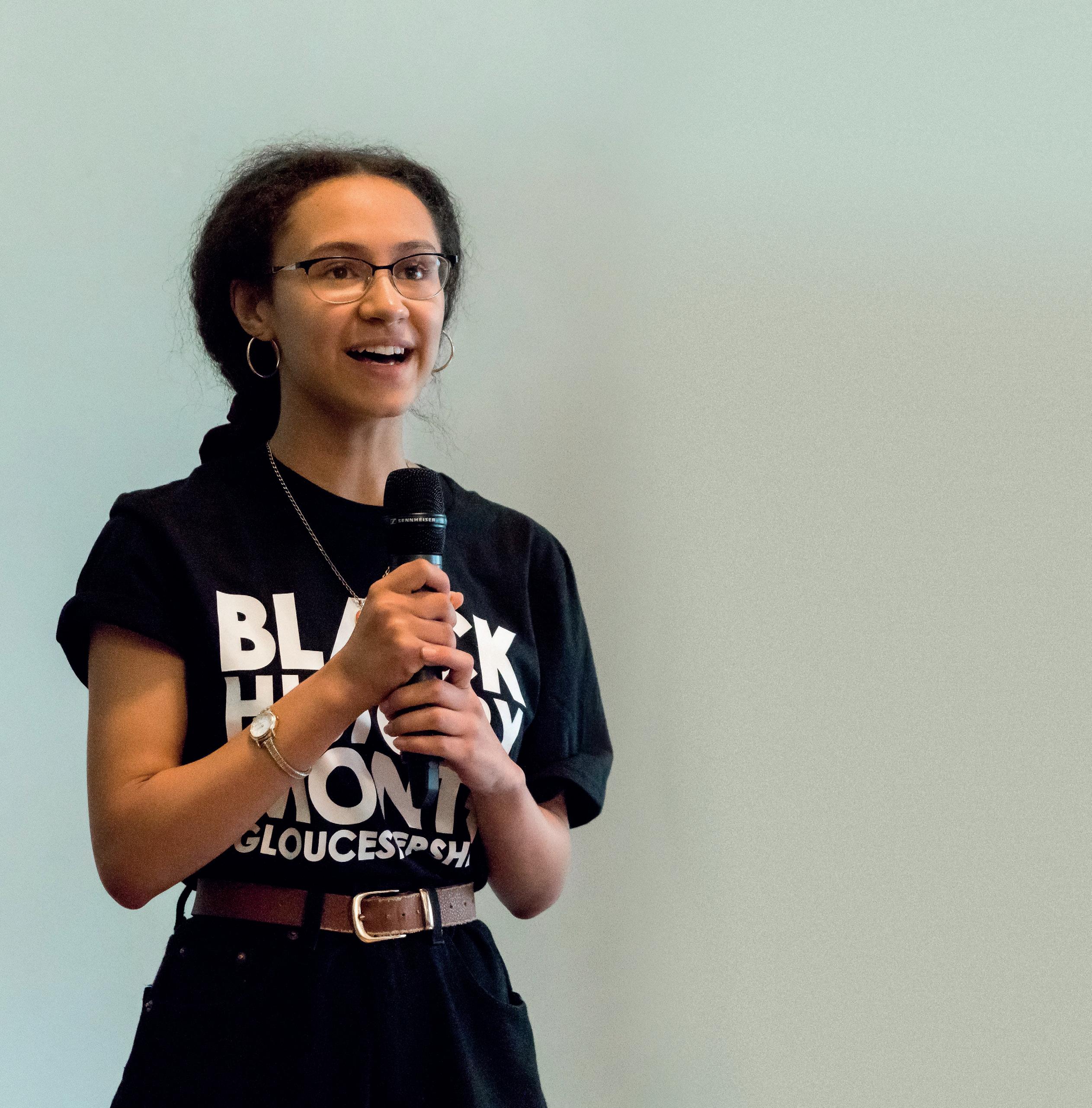
WELCOME
Dear Colleagues and Partners,
We, at the Lives of Colour team, would like to extend a warm welcome and thank you for agreeing to participate in our joint conference,
Transforming Diversity and Inclusion: Progressive Actions for Equitable Futures.
We look forward to the coming discussions, and the initiation of positive, affirmative ideas to help to move Gloucestershire forward to becoming a more inclusive society for all, both personally and professionally.
The application of our G.R.A.D.E.E.S (overleaf) inclusion strategy is one we have been working on for years, and it is a tree that has already born fruit for many individuals, communities, and organisations. However, all things done well, are done better when we work together for a common aim.
We are so excited to hear from you, influencers, policy, and decision makers and leaders in our community, and to work together to develop a race and equity plan for Cheltenham/Gloucestershire.
2020 has been an extraordinary year, one that has caused many to re-evaluate their individual positions in the world. We have seen a blossoming interest in the community for diversity, equality, and inclusion, and we believe this will continue to lead towards a better and more equitable future for all. It simply remains for us to identify what actions we take, and how this is administered.
‘Teamwork is the ability to work together toward a common vision. The ability to direct individual accomplishments towards organisational objectives. It is fuel that allows common people to attain uncommon results’ Andrew Carnegie.
Yours Sincerely,
Florence Nyasamo-Thomas Founder Lives of Colour
OUR MISSION AT LIVES OF COLOUR IS TO ELEVATE THE VOICES OF MARGINALISED COMMUNITIES BY WORKING WITH INDIVIDUALS, COMMUNITIES AND ORGANISATIONS THROUGH EDUCATION, EVENTS AND TRAINING PROGRAMMES. WE DO THIS BY USING OUR G.R.A.D.E.E.S INCLUSION STRATEGY. IT DENOTES: GENDER, RELIGION, AGE, DISABILITY, ETHNICITY, ECONOMIC STATUS AND SEXUAL ORIENTATION, ALL CHARACTERISTICS WHICH AFFECT THE WAY PEOPLE EXPERIENCE LIFE.
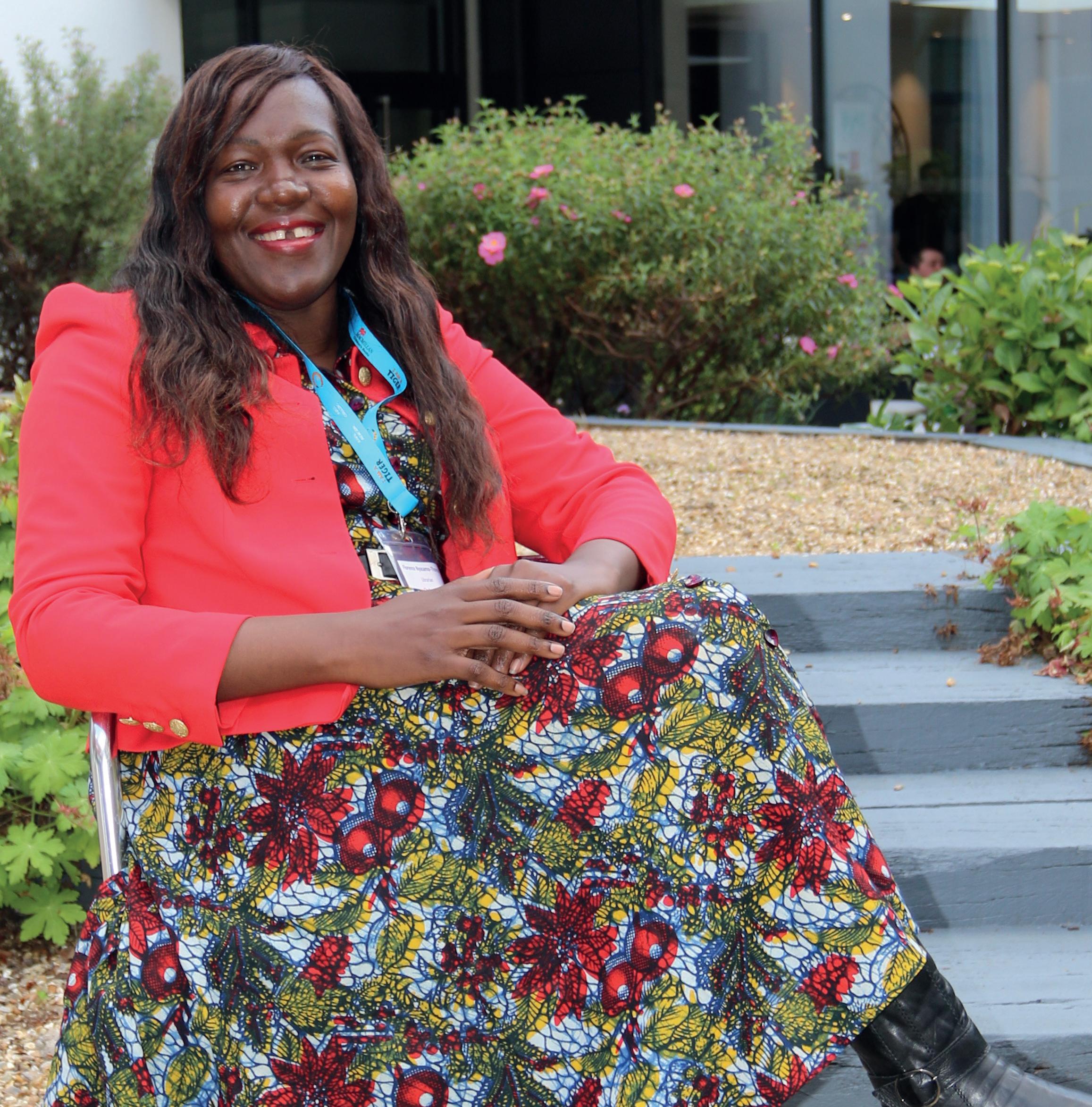
WHAT WE DO;
DIVERSITY AND INCLUSION TRAINING
CONVERSATION OF COLOUR
AUTHORS OF COLOUR
© Lives of Colour 2020 Nowans Community Trust 1137971 Published November 2020
LIVES OF COLOUR REPORT AND CONFERENCE PROPOSAL
CONTENTS
Background ............................................................................................. 2
Strategy for Developing Black Lives Matter – 2020 and Beyond ........... 3
Themes and Proposed Actions ............................................................... 4
Care and Outreach in Schools ................................................................. 4
Workplaces and Economies .................................................................... 5
Communities and Local Democracy ........................................................ 5
Community Engagement ........................................................................ 6
Reaching Communities ........................................................................... 6
Proposal Participants ............................................................................... 7
Conclusion ............................................................................................... 9
Bibliography .......................................................................................... 10
References ............................................................................................. 15
BACKGROUND
Arrangements for the conference should address the Cheltenham Borough Council Motion: Cheltenham Borough Council believes in action, not just fine words. In conjunction with the Police and Crime Commissioner, Cheltenham Borough Homes, Cheltenham Trust, Festivals and other partners, Cabinet is requested to look at holding a conference for Cheltenham’s BAME community organisations, to discuss how we might work closer together to challenge bias, both deliberate and unconscious, and racism in all its forms. Lives of Colour was tasked with putting this report together from discussions from Cheltenham Borough Council developing a strategy to support the BAME community in the months following the exponential rise of Black Lives Matter movement. It is vital to address long-term inequalities and make sure that vulnerable communities are in a position to thrive in a postCovid society, and we can create a stronger, better and more compassionate Cheltenham by mindfully taking action to uplift people.
Any initiatives of this measure should be led directly by BAME people, as they are directly impacted by any potential measures, and they have direct lived experience and solid expertise in working with communities and developing solutions to ongoing problems.
There are concerns that BAME people are not currently centred in these discussions and projects as they should be, and a conference and ongoing group working in coordination with local councils will effectively address these concerns.
Through summer 2020, we have seen some of the limitations of our society and the way it functions frequently on systemic inequalities. We have an opportunity to address this in cooperation with recovering from the effects of covid-19, ambitiously tackling climate breakdown, supporting displaced people experiencing geopolitical instability and displacement, and making our communities more resilient across internal changes in the face of our society.
An engagement exercise to hold Cheltenham accountable and to inform people on how severe and entrenched UK racism is, even in comparison with the US.
The council, schools, police, and other municipal organisations need to commit firmly to anti-racist measures, positive organisational strategy, and inclusivity from the bottom up, instead of continuing ignorant and malicious practices that directly harm people’s livelihoods and welfare.
There needs to be stronger community representation and prominent people taking up positions of responsibility.
Nabeela suggested that there aren’t enough community groups taking this kind of action, and there needs to be stronger opposition positions on the norm of racial intolerance and erasure of marginalised communities.
We also have elected councillors who are on record making offensive statements and using harmful language, who have continued to operate as public servants.
Empowering people to become activists and not only supplying information to them, but also directing them with concrete ways to create change.
Enabling BAME people to take centre stage in discussions, while also ensuring their mental wellbeing throughout and shielding them from any inflammatory backlash, should such arise.
There needs to be practical ways for white people to become active and compassionate allies, and put themselves at the forefront of the struggle to take on a greater share of the risk involved, while simultaneously amplifying BAME voices above their own, trusting and uplifting their experiences, and centring them at the heart of the conversation.
Eby suggested that we need to identify what allyship looks like and find ‘accomplices’ who recognise that while we may have different agendas, we can uplift ourselves by uplifting other people as well, by recognising intersections in our oppression and fighting for liberation for all of us as a collective. Empower BAME communities to become more autonomous and self-supporting while also forming links between them to strengthen them and develop an overarching movement.
THEMES AND PROPOSED ACTIONS
CARE AND OUTREACH IN SCHOOLS
We need strong visible representation for children and sharing positive role models, as well as mentorship programs to give people powerful visions of their own capacity and ability.
Diverse book club for all ages and pupils.
Sharing personal and professional development opportunities and careers guidance.
Creating a resilient collaborative listening culture with opportunities for diverse communities to give feedback in an open and non-judgemental environment.
Pastoral support including assistance for those with physical or learning disabilities, and diagnostic for children with apparent behavioural issues who may instead be neurodiverse.
Mental health provision with someone trained specifically on issues that affect BAME people.
Education on Black hair and hairstyles, including ensuring that natural and protective hairstyles aren’t maligned or eradicated with uniform policy, and helping to provide guidance for white parents to learn how to take care of Black hair.
Assemblies and workshops several times a year to discuss colonialism and systemic racism so that children are familiar with the issues, appreciate our differences, and empowered to address oppression within both their own behaviour and prejudices, and with other people.
Give key support for BAME staff members who will be facing pressure from daily news cycles, potential harassment from both within work and outside it, and systemic harm from an enforced socioeconomic position.
Celebrate and spotlight different cultures and world histories, and develop inclusive curriculums.
Create proactive working partnerships with local cultural communities.
WORKPLACES AND ECONOMIES
A working group developed to support BAME people who are out of work or study.
Inclusivity programs for industries with lower uptake or typically less diverse representation, including the arts, environment, etc.
Protections for health workers and essential workers who are typically from BAME backgrounds and endure poor or unsafe working conditions.
Public information campaigns on how to address ongoing racial harassment and profiling, and how to take meaningful action to prevent it from arising.
Supporting public transport and creating better alternative transport infrastructure so that people living on a lower salary has more disposable income and don’t have to afford the expenses of owning and maintaining a car.
Supporting businesses and organisations in creating best practices and affirmative action programs.
Rolling out awareness training of how to deal with racially abusive customers or internal workers, as well as other situations.
COMMUNITIES AND LOCAL DEMOCRACY
Develop a strategy for nurturing diverse talent and mentoring parish, borough and county council candidates.
Share opportunities to represent on charitable trusts and boards of directors.
Regular citizens assemblies.
Voter engagement drives to encourage local diverse communities to vote and participate in council actions.
Have firm commitments from upper levels of democratic institutions and cabinets, rather than simply inclusivity officers who sometimes struggle to get progressive and ambitious motions through.
COMMUNITY ENGAGEMENT
REACHING COMMUNITIES
Key organisations to initially reach out to include:
Police
University of Gloucestershire School networks
Business networks
Gloucester College NHS hospitals and social care Faith groups
Jermaine suggests the project needs to be an intersectional approach giving people from all backgrounds an opportunity to engage.
Reaching out to other Gloucestershire-based BLM groups across social media.
Maureen suggested launching an open meeting, possibly a few across different times, online and offline, and advertised across different platforms, and make it free for anyone to come and drop by.
PROPOSAL PARTICIPANTS
Florence: Florence is the founder of Lives of Colour and has worked for over ten years within community development settings in both the UK and abroad. She is a passionate speaker, educator, and mentors’ young people. She works with them, encourages and empowers them to reach their goals. In 2018, she created the G.R.A.D.E.E.S. (page 4) inclusion workshop, a part of the Lives of Colour training programme, to support schools, organisations and businesses with diversity and inclusion strategies. She recently launched the Authors of Colour initiative which includes a curation of diverse books for schools and families. She is an innovator who has led different projects for the Heritage Fund, Awards for All and was part of the team that founded FestivALL in Gloucestershire. Most recently she curated the I-MMIGRATE exhibition that showcased the portraits and oral histories of the Windrush generation and African diaspora in Gloucestershire. This was exhibited at the Museum of Gloucester until the end of October 2020. In Gloucestershire she has organised Black History Month Gloucestershire events since 2014 and this summer co-hosted the Black Lives Matter event in Cheltenham. She has facilitated summer volunteer trips for students as part of @ProjectKenya to go work in an orphanage and school in Kenya, organised by Nowans Community Trust and continues to support the orphanage and school.
Nabeela: I’m from Birmingham, have lived in Cheltenham since 2010 and AWP, worked clinically in mental health NHS, social care for a number of years. With time the roles become more specific, limited in terms of engagement & outreach reflecting the services. These have been both paid volunteer roles with marginalised communities in a variety of settings including looked after children from many different backgrounds including refugees, these were mostly Afghan in earlier 2000s, otherwise I’ve supported or worked with children, young offenders, survivors of domestic abuse, homeless, learning difficulties, neuro diverse.
Eby grew up in London in a close-knit community where people looked out for one another, and he’s found that Cheltenham doesn’t have a similarly cohesive community. He wants to see that happen here. When he participated in the Black Lives Matter movement, he had the realisation that he’d been prepared for this throughout the course of his life and he felt now is the time to speak out and build something new. He’s concerned that some of the momentum of the summer protests has been lost, and wants to ensure that the substantial and practicable action continues.
Jermaine has been campaigning for a conference of this nature for a long time, and is now working with Florence to bring it to reality. His ambition is to reduce inequality at first in Cheltenham and then further beyond. He’s considering establishing channels through which people can share their experiences so we can proactively help to address them. He’s lived in Cheltenham for the past ten years, and has approached Florence to work on a conference and ensure that it’s a project led fundamentally by the people most affected by the issues it concerns. He’s a Doctor of Psychology working at University of Bath.
Tabi’s worked for Cheltenham Welcomes Refugees for the past three years carrying out external liaisons and media work. Having lived in Cheltenham most of her life, she is frustrated by the reserved views of many local people who do not recognise the limits of their own understanding in these issues, and feels positive change has been happening much too slowly to be of effective use to diverse communities.
Maureen: I am an educator by training B.ED (Home Economics ) Kenyatta University, Kenya.
I have lived Cheltenham for 13 years after having lived and worked in Germany and Italy. I currently work at St Gregory’s Childcare trust.
I have a heart for children and passionate in all matter’s children. I have been blessed to be able to support children and institutions in my village of Wote, Makueni Kenya where I was involved a school building and renovation of schools and organising fund-raising activities for these projects. I have worked to put in place a school feeding programme for Nursery school children from poor and vulnerable families.
My latest project is called “2 Cows Farm Community Sports Project” where we encourage children and young adults of ages 3-24 to engage in sports, we have managed to keep over 50 children off the streets and villages and continue to educate them on the dangers of drugs, alcohol and also on issues like pregnancies, STDs, and HIV and Aids.
Mary has lived in Cheltenham for twenty years and she met Florence at the University of Gloucestershire. She’s wanted to become a part of this conference because she’s aware that BAME communities have been disproportionately impacted by coronavirus, being on the front line both as healthcare workers and as essential community workers, and she feels that the long-standing issues of racial tension and inequality need to be urgently addressed. She’s a social worker and she’s seen first-hand the effects of the way we respond inappropriately to children of colour who need help, and don’t receive the sensitivity that they really deserve.
Natalie is Chair of Cheltenham Welcomes Refugee
CONCLUSION
The report highlights the issues faced by Black, Asian and Minority Ethnic communities in Cheltenham and Gloucestershire. It is supported by various research papers and findings as indicated in our bibliography. Discrimination, unconscious bias and racial inequality continue to affect the lives of culturally diverse communities in Cheltenham and the UK. This year Covid-19 pandemic has exposed how much our system is unequal. Inequality of outcome in education, income, health, employment and criminal justice systems is evident in all aspects of BAME lives. We believe that It is the responsibility of all institutions, private and statutory, to listen to and work together with BAME communities and organisations to find solutions and best practices to effectively ensure equitable futures. By engaging the community from the beginning and, supporting the community members in organising and running this conference, it is an example of an institution empowering and including BAME communities to shape a more inclusive society for everyone.
BE NAÏVE, WHEN MANY OF THOSE RECEIVING THOSE
SAME SERVICES ARE TELLING US THAT RACISM, BOTH
INDIVIDUAL AND INSTITUTIONAL, IS ALIVE AND WELL.
SOME INCONVENIENT TRUTHS, THAT WE CAN LIVE IN A TRULY
INCLUSIVE SOCIETY1 .
Taking the words from 1 ‘To rely solely upon legislative reform to resolve the inequalities which plague our mental health services would be naïve, when many of those receiving those same services are telling us that racism, both individual and institutional, is alive and well. It is only by deeply listening to and acting upon their powerful narratives, which may well contain some inconvenient truths, that we can hope to offer everyone the mental health support that they deserve’. (N. Dissanayaka, 2020)
BIBLIOGRAPHY
SCHOOLS
“The gap in attainment between the poorest children and children from better-off backgrounds, already large at age 5, grows particularly fast during the primary school years. By age 11, only around three quarters of children from the poorest fifth of families reach the government’s expected level at Key Stage 2, compared to 97% of children from the richest fifth” (J. Rowntree Foundation; 2010)
https://www.jrf.org.uk/report/poorer-children’s-educational-attainment-how-important-are-attitudes-and-behaviour
SCHOOLS AND EXCLUSIONS
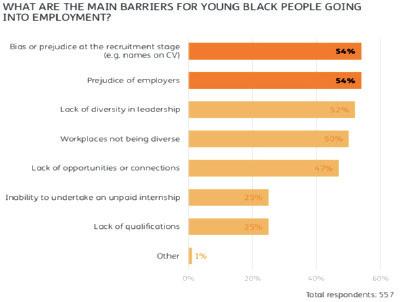
Child poverty and education outcomes by ethnicity
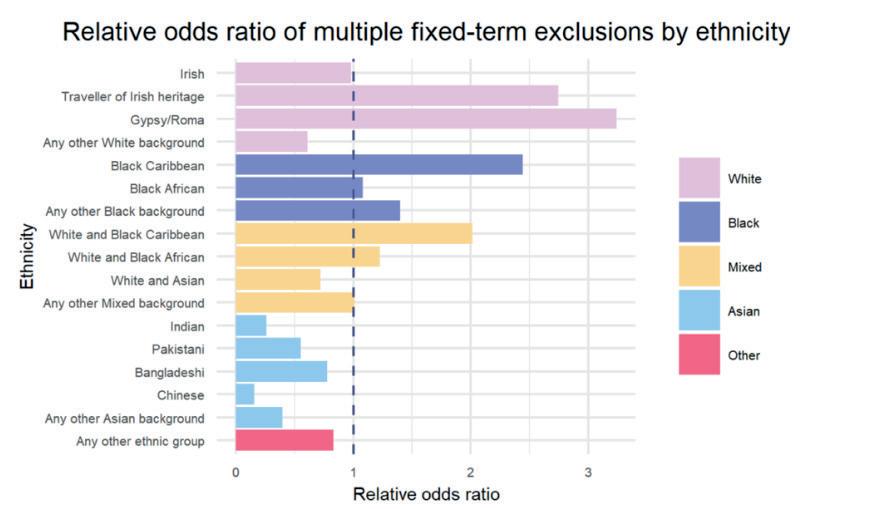
Figure 1 In the 2018/19 academic year
‘In Gloucestershire, pupils of Black Caribbean heritage are 5.6 times more likely than their White British peers, to face multiple fixed-term exclusions’ I(ntegratED; 2020) https://www.integrated.org.uk/2020/07/30/the-disproportionality-of-fixed-term-exclusions/
HIGHER EDUCATION
‘University staff often lack the understanding, skills, and confidence to manage conversations about race effectively. This can lead to anxiety in managing incidents of racial harassments because of fear of getting it wrong and possible facing allegations of racial discrimination. This in turn undermines fair treatment and the prospect of early resolution’ (Cooper, 2019.8.)
(EHRC, 2019.8) https://www.equalityhumanrights.com/sites/default/files/tackling-racial-harassment-universitieschallenged.pdf
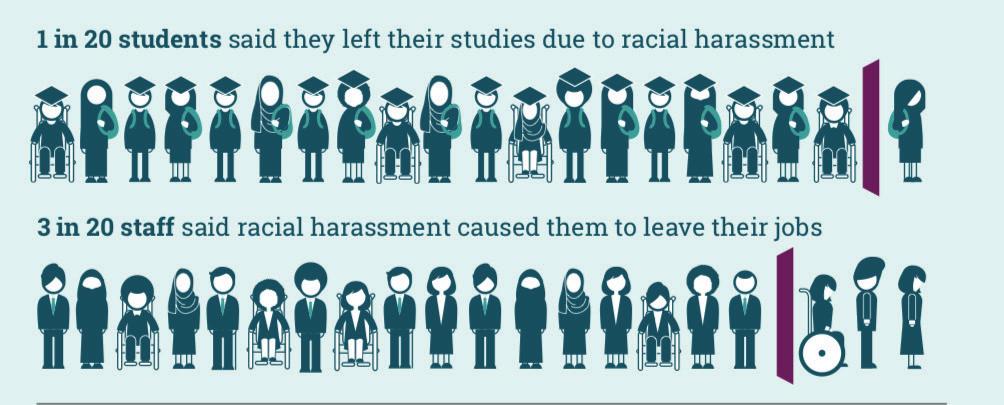
‘In 2015/16, 78.4% of white students received a first or 2:1, compared with only 63.4% of ethnic minority students, representing an attainment gap of 15.0 percentage points. The gap was particularly large for Black African and Black Caribbean students (percentage points gaps of 26.0 and 22.5 respectively) but much smaller for Chinese and Indian graduates’. (EHRC, 2018:34)
https://www.equalityhumanrights.com/sites/default/files/is-britain-fairer-accessible.pdf
YOUNG AND BLACK:
‘95% of young Black people report that they have heard and witnessed the use of racist language at school, and 78% of young Black people reported hearing and witnessing racist language in the workplace. Young Black people said that they expect to experience racism because of the colour of their skin.’ (YMCA, 2020:7)
‘Young Black people felt that society typically views them as “the class clown” or “underachiever”. As a result, young Black people explained that some teachers automatically view young Black people as“less capable”, “unintelligent” and “aggressive’. (YMCA; 2020:12)
https://www.ymca.org.uk/wp-content/uploads/2020/10/ymca-young-and-black.pdf
EMPLOYMENT
The higher rates of child poverty experienced by BME groups (rising to over half of Pakistani children) are particularly striking. Child poverty is not only bad for children in terms of their experience at school and relationships with
parents and wider family, but it provides people with a disadvantaged start in life. (Runneymede: 2020:8)

There is evidence of discrimination in Britain, including in the labour market. For example, research has found that people with Asian or African-sounding surnames had to send in nearly twice as many curriculum vitae (CVs) just to get an interview (Wood et al., 2009; Di Stasio and Heath, 2019). This is hardly ‘indirect’ discrimination or ‘unconscious bias’, as it involves people refusing to offer an equally qualified candidate an interview solely because of their surname. (Runnymede; 2020:10)
https://www.runnymedetrust.org/uploads/publications/pdfs/2020%20reports/The%20Colour%20of%20Money%20Report.pdf
(YMCA; 2020:22) https://www.ymca.org.uk/wp-content/uploads/2020/10/ymca-young-and-black.pdf
HOUSEHOLDS
Black and minority ethnic households are, on average, larger than white British households. The most common household size in Britain among adults is two people (34%); by contrast, the most common household size among adults from a BME background is four people (25%). BME groups, on average, are more than twice as likely as white people to live in households of five people or more.
https://www.runnymedetrust.org/uploads/Runnymede%20Covid19%20Survey%20report%20v3.pdf
WEALTH
BAME people generally have much lower levels of savings or assets than White British people. Indian households have 90–95p for every £1 of White British wealth, Pakistani households have around 50p, Black Caribbean around 20p, and Black African and Bangladeshi approximately 10p. (Runneymede,2020:12)
Relative wealth by ethnic group Figure 6 (Runnymede; 2020:13)
https://www.runnymedetrust.org/uploads/publications/pdfs/2020%20reports/The%20Colour%20of%20Money%20Report.pdf
HEALTH
An analysis of survival among people with confirmed COVID-19 by sex, age group, ethnicity, deprivation and region, shows that, after taking these factors into account, some ethnic groups still had a higher risk of death than others (Appendix A). This analysis looked at 16 ethnicity categories and found that, when compared to White British ethnicity, people of Bangladeshi ethnicity had twice the risk of death. People of Chinese, Indian, Pakistani, Other Asian, Black Caribbean and Other Black ethnicity had between 10 and 50% higher risk of death when compared to White British (Appendix A, table A1). (Public Health England, 2020:45)
https://assets.publishing.service.gov.uk/government/uploads/system/uploads/attachment_data/file/908434/ Disparities_in_the_risk_and_outcomes_of_COVID_August_2020_update.pdf
BLACK WOMEN AND HEALTH
Black women are five times more likely to die in childbirth than white women. Findings from MBRACE-UK findings. Woman’s Hour (BBC Radio 4: 2019)
https://www.npeu.ox.ac.uk/mbrrace-uk/news/1834-npeu-news-black-women-are-five-times-more-likely-to-die-inchildbirth-than-white-women-why
MENTAL HEALTH
‘There is growing evidence that suggests that discrimination and particularly experiences of racism (interpersonal and institutional) contribute to increased likelihood of developing mental health problems. Experiences of racism has been linked to increased likelihood of developing depression; hallucinations and delusions; and if physical assault is involved, post-traumatic stress’(Mind: 2020:5)
https://www.mind.org.uk/media/6484/race-equality-briefing-final-oct-2020.pdf
BAME communities are more than any other group likely to be referred to mental health services through criminal justice. “Patients from the White British group were less likely than average to be referred by the criminal justice agencies, whereas the Black Caribbean, Black African, Other Black, White/Black African Mixed and Other Asian groups were 30% to 83% more likely than average to be referred in this way” (Care Quality Commission: 2010:21).
https://www.cqc.org.uk/sites/default/files/documents/count_me_in_2010_final_tagged.pdf
CRIMINAL JUSTICE
BME communities experience a range of inequalities which can put them at greater risk of mental health problems and encounters with the CJS. Many BME communities occupy particular positions of disadvantage in the UK. They experience inequalities across all indicators of economic and social wellbeing. They generally have higher rates of unemployment, live in poorer housing, report poorer health, and have lower levels of academic achievement (Keating, 2007). (The Bradley Commission, 2013:3)
https://www.centreformentalhealth.org.uk/sites/default/files/2018-09/Bradley_Commission_briefing1_BME.pdf
Despite making up just 14% of the population, BAME men and women make up 25% of prisoners,4 while over 40% of young people in custody are from BAME backgrounds. If our prison population reflected the make-up of England and Wales, we would have over 9,000 fewer people in prison5 – the equivalent of 12 average-sized prisons.6 There is greater disproportionality in the number of Black people in prisons here than in the United States (Lammy Review, 2017:3)
https://assets.publishing.service.gov.uk/government/uploads/system/uploads/attachment_data/file/643001/lammyreview-final-report.pdf
REFERENCES:
BBC Radio 4 Woman’s Hour (2019) Black Women are five times more likely to die in Childbirth than white women. MBBRACE-UK findings https://www.npeu.ox.ac.uk/mbrrace-uk/news/1834-npeu-news-black-women-arefive-times-more-likely-to-die-in-childbirth-than-white-women-why
P. Cooper (2019) Tackling Racial Harassment University Challenge. Equality and Human Right Commision. https://www.equalityhumanrights.com/sites/default/files/tackling-racial-harassment-universities-challenged.pdf
N. Dissanayaka (2020) Racial disparity in mental health: challenging false narratives. Centre for Mental Health https://www.centreformentalhealth.org.uk/racial-disparity-mental-health-challenging-false-narratives
EHRC (2019) Is Britain Fairer? The state of equality and human rights. Equality and Human Right Commision. https://www.equalityhumanrights.com/sites/default/files/is-britain-fairer-accessible.pdf
IntergraED (2020) The disproportionality of fixed-term exclusions https://www.integrated.org.uk/2020/07/30/the-disproportionality-of-fixed-term-exclusions/
Haroon Chowdry Claire Crawford Lorraine Dearden Robert Joyce, Luke Sibieta Kathy Sylva Elizabeth Washbrook (2010) Poorer children’s educational attainment: how important are attitudes and behaviour? Joseph Rowntree Foundation. https://www.jrf.org.uk/report/poorer-children’s-educational-attainment-how-important-are-attitudes-and-behaviour
Lammy Review (2017) An independent review into the treatment of, and outcomes for, Black, Asian and Minority Ethnic individuals in the Criminal Justice System https://assets.publishing.service.gov.uk/government/uploads/system/uploads/attachment_data/file/643001/lammyreview-final-report.pdf
Magali Duque and Abigail McKnight (2019) ‘Understanding the Links Between Inequalities and Poverty (LIP)’ The London School of Economics. Joseph Rowntree Foundation https://www.researchgate.net/publication/337085190_Understanding_the_Links_between_Inequalities_and_Poverty_ LIP_Understanding_the_relationship_between_inequalities_and_poverty_a_review_of_dynamic_mechanisms
Mind for Better Mental Health (2020) Inequalities for Black Asian and Minority Ethnic Communities in NHS Mental Health Service in England. Mind https://www.mind.org.uk/media/6484/race-equality-briefing-final-oct-2020.pdf
Nancy Kelley, Omar Khan, Sarah Sharrock (2017) Racial Prejudice in Britain Today. Natcern Social Research https://natcen.ac.uk/media/1488132/racial-prejudice-report_v4.pdf
National Mental Health Unit (2010) Count me in 2010. Care Quality Commission Count
NHS (2010) Race: Evidence of health inequalities affecting black and minority ethnic people https://www.bdct.nhs.uk/wp-content/uploads/2016/12/Race.pdf
O. Khan (2020) ‘The Colour of Money’ Runnymede. https://www.runnymedetrust.org/uploads/publications/pdfs/2020%20reports/The%20Colour%20of%20Money%20Report.pdf
Public Health England, (2020) ‘Disparities in the Risks and Outcomes for Covid-19’. https://assets.publishing.service.gov.uk/government/uploads/system/uploads/attachment_data/file/908434/ Disparities_in_the_risk_and_outcomes_of_COVID_August_2020_update.pdf
The Bradley Commission (2013) Black and Minority Ethnic communities, mental health and criminal justice Centre for Mental Health https://www.centreformentalhealth.org.uk/sites/default/files/2018-09/Bradley_Commission_briefing1_BME.pdf
YMCA (2020) “Young and Black Experience of institutional Racism” YMCA England and Wales. https://www.ymca.org.uk/wp-content/uploads/2020/10/ymca-young-and-black.pdf
Zubaida Haque, Laia Becars and Nick Treoar (2020) ‘Over Exposed and Under Protected’. Runneymede https://www.runnymedetrust.org/uploads/Runnymede%20Covid19%20Survey%20report%20v3.pdf
ACKNOWLEDGEMENTS:
We would like to express our sincere gratitude to the following teams for all their contributions to this report. It is through sheer commitment, determination and generosity that we were able to gather expert information that will bring real change to the culturally diverse communities in Cheltenham, Gloucestershire and beyond. Furthermore, we would like to give special gratitude to Cheltenham Borough Council for their support in making this conference possible.
Eberechi Ukandu
Jermaine Ravalier Maureen George Mary Mackie Natalie Genes
Nabeela Akhtar Tabitha Joy Florence Nyasamo-Thomas
The term Black Asian and Ethnic Minority (BAME) has had a lot of focus in the media recently and became prominent due to the fatality suffered by many people from culturally diverse communities because of tCOVID-19 and the Black Lives Matter movement protest events. In our report we have used the word BAME because many of the research papers we have referred to have use this term. However, our preferred terms are Culturally Diverse Communities or Ethnically Diverse Communities.
INEQUALITIES ASSOCIATED WITH RACE
ARE ENDEMIC IN UK SOCIETY, ACROSS INCOME, EDUCATION, WORK, HEALTH, AND CRIMINAL JUSTICE. PUBLIC DEBATE OFTEN FOCUSES ON EXTREME OR OVERT FORMS OF RACISM EXPRESSED BY INDIVIDUALS, SUCH
AS HATE CRIMES, OR THE MORE DISTANT, IMPERSONAL CONCEPT OF INSTITUTIONAL
RACISM. IN THIS CONTEXT, IT IS PERHAPS
IMPORTANT ALSO TO CONSIDER THAT
THE CULTURES AND PRACTICES OF OUR
PUBLIC AND PRIVATE INSTITUTIONS ARE
MADE BY INDIVIDUAL PEOPLE, AND THAT
EVEN SUBTLE PREJUDICES CAN LEAD TO
SIGNIFICANT INEQUALITIES
(N.KELLY, O. KHAN, S.SHARROCK, 2017:12)

e G Ö ú info@livesofcolour.co.uk www.livesofcolour.couk
© Lives of Colour 2020 Nowans Community Trust 1137971. Published November 2020



